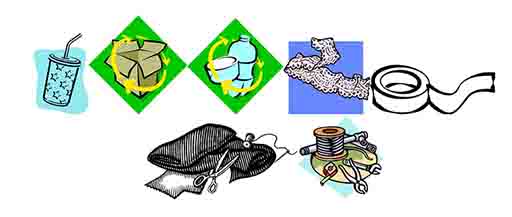Resource 4: Plant models
![]() Teacher resource for planning or adapting to use with pupils
Teacher resource for planning or adapting to use with pupils
Before this activity, ask your pupils to bring in scrap materials. Collect some yourself. Scrap materials might include: tin; cardboard; string; tape; straws; plastic bottles; fabric; paper; netting; wire.
Step 1: Divide your class into small groups of three or four pupils. Write the following instructions on the chalkboard or give each group an instruction card:
| Talk about what a plant looks like. Then make models of the plants from the scrap materials. |
Step 2: Organise the scrap materials so that each group has a selection to use.
Step 3: Give your pupils time to plan and build their models.
Step 4: Ask each group to come to the front in turn and explain their model to the class.
How the lesson went for Okoro
The plant models that the pupils made showed that they knew the basic structure of a plant, but they were not too sure of the details, like bark, side branches and where the leaves are on branches.
She decided to let them look at plants outside and then return to their models and change or add to them. Her pupils had some knowledge of the terminology but not enough in English or their mother tongue, so they used a mixture of both. There were some plant parts they did not know the names of in either language.
To help pupils, she developed a lexicon (a small dictionary) to show which words the pupils knew to describe the parts of plants that they were familiar with:
(You might find it helpful to put up these words round your classroom and encourage the pupils to use them when talking about their models).
| Lexicon of plant terms | |
| Simple terms | More advanced terms for older pupils |
| * root | tap root, side root |
| * stem | bark |
| * leaf | vein |
| * bud | |
| * flower | petal, anther, pollen, ovule |
| * fruit | fleshy, dry, case |
| seed | radicle (baby root) plumule (baby shoot) cotyledon (food store) |
Adapted from: Primary Science Programme – Teaching the Topic Plants
Resource 3: The seven common characteristics of all living things




